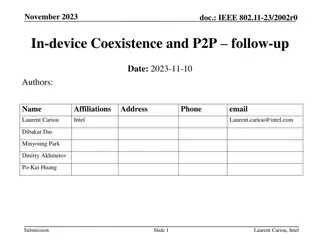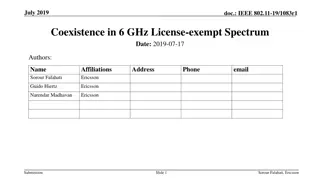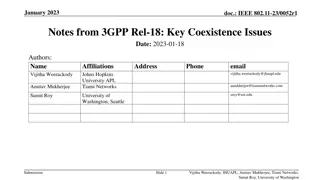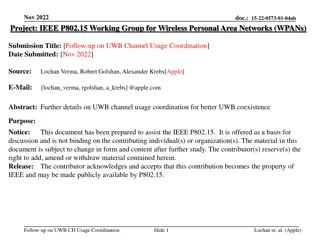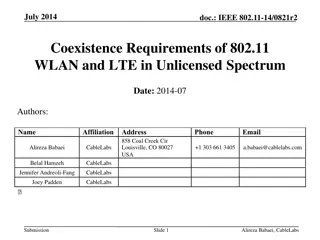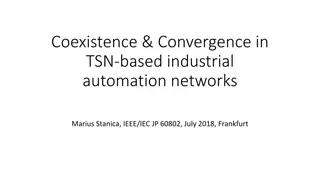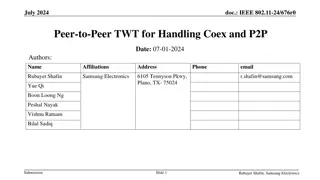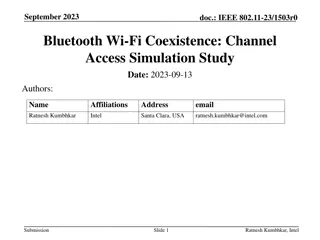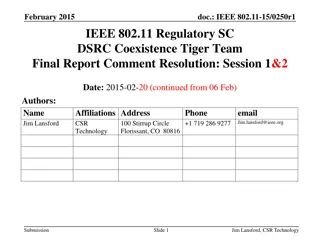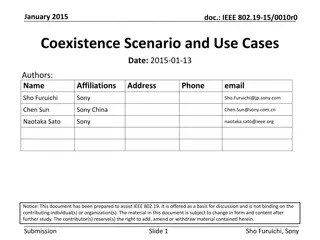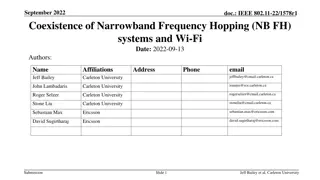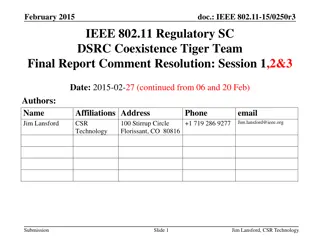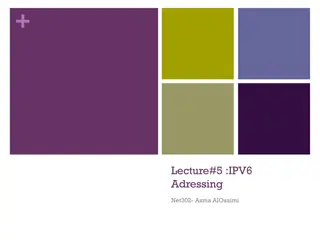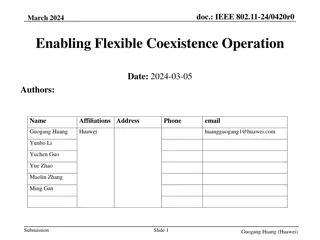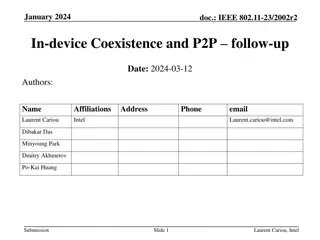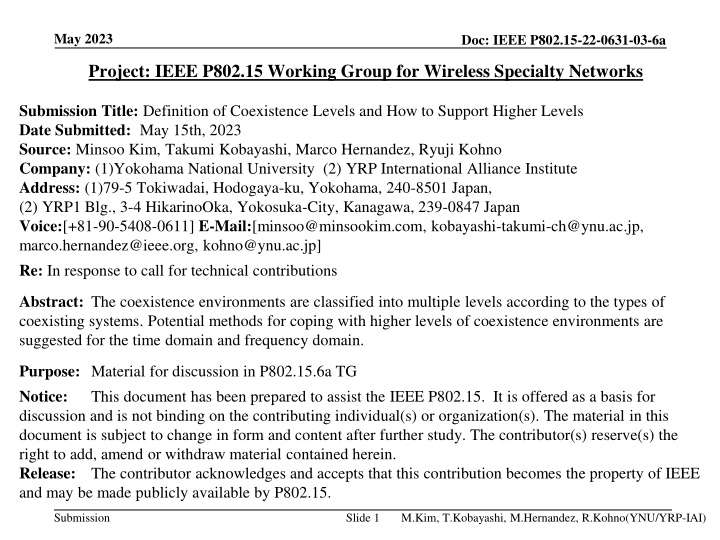
Defining Coexistence Levels for Wireless Networks
Explore how coexistence levels are categorized for wireless networks and learn methods to manage higher levels effectively. This submission discusses challenges, solutions, and the importance of defining levels in achieving dependability for Body Area Networks and other radios in shared environments.
Download Presentation

Please find below an Image/Link to download the presentation.
The content on the website is provided AS IS for your information and personal use only. It may not be sold, licensed, or shared on other websites without obtaining consent from the author. If you encounter any issues during the download, it is possible that the publisher has removed the file from their server.
You are allowed to download the files provided on this website for personal or commercial use, subject to the condition that they are used lawfully. All files are the property of their respective owners.
The content on the website is provided AS IS for your information and personal use only. It may not be sold, licensed, or shared on other websites without obtaining consent from the author.
E N D
Presentation Transcript
May 2023 Doc: IEEE P802.15-22-0631-03-6a Project: IEEE P802.15 Working Group for Wireless Specialty Networks Submission Title: Definition of Coexistence Levels and How to Support Higher Levels Date Submitted: May 15th, 2023 Source: Minsoo Kim, Takumi Kobayashi, Marco Hernandez, Ryuji Kohno Company: (1)Yokohama National University (2) YRP International Alliance Institute Address: (1)79-5 Tokiwadai, Hodogaya-ku, Yokohama, 240-8501 Japan, (2) YRP1 Blg., 3-4 HikarinoOka, Yokosuka-City, Kanagawa, 239-0847 Japan Voice:[+81-90-5408-0611] E-Mail:[minsoo@minsookim.com, kobayashi-takumi-ch@ynu.ac.jp, marco.hernandez@ieee.org, kohno@ynu.ac.jp] Re: In response to call for technical contributions Abstract: The coexistence environments are classified into multiple levels according to the types of coexisting systems. Potential methods for coping with higher levels of coexistence environments are suggested for the time domain and frequency domain. Purpose: Material for discussion in P802.15.6a TG Notice: This document has been prepared to assist the IEEE P802.15. It is offered as a basis for discussion and is not binding on the contributing individual(s) or organization(s). The material in this document is subject to change in form and content after further study. The contributor(s) reserve(s) the right to add, amend or withdraw material contained herein. Release: The contributor acknowledges and accepts that this contribution becomes the property of IEEE and may be made publicly available by P802.15. Submission Slide 1 M.Kim, T.Kobayashi, M.Hernandez, R.Kohno(YNU/YRP-IAI)
Doc: IEEE P802.15-22-0631-03-6a May 2023 MAC Proposal of TG15.6ma (Revision of IEEE802.15.6-2012) Definition of Coexistence Levels and How to Support Higher Levels May 15th, 2022 Minsoo Kim, Takumi Kobayashi, Marco Hernandez, and Ryuji Kohno Yokohama National University(YNU), YRP International Alliance Institute(YRP-IAI) Submission Slide 2
May 2023 Doc: IEEE P802.15-22-0631-03-6a Introduction The goal of this revision is to enhance dependability. This presentation focuses on the challenges of coexistence, among other obstacles we face in achieving this goal. There is no one-size-fits-all solution to manage any coexistence scenario. To start with, we are outlining the various levels of coexistence scenarios we anticipate in an environment where one or more Body Area Networks (BANs) and other radios are operating within the same coverage area. TG6ma is working on defining specification at the Physical (PHY) and Media Access Control (MAC) layers to enhance dependability at each the level, maintaining a specific Quality of Service (QoS). Submission Slide 3 M.Kim, T.Kobayashi, M.Hernandez, R.Kohno(YNU/YRP-IAI)
May 2023 Doc: IEEE P802.15-22-0631-03-6a Definition of Coexistence Environment Levels Coexisting system(s) Coexiste nce Level Non-802.15 UWB (ex. ETSI SmartBAN) Non-UWB (ex. Wi-Fi / Unlicensed / 3GPP) 802.15 UWB (ex. 802.15.4) Category 802.15.6- 2012 802.15.6ma 0 - - - - - Single BAN 1 (1a) - - - - Multiple 15.6 BANs 2 (1b) - - - 3 - - - Non-UWB 4 (2a) - - - Multiple UWB systems 5 (2b) - - - 6 (2c) - - 7 Final Boss We ve redefined coexistence into 8 levels, each of which can be represented using just 3 bits. This make them suitable to include in PHY or MAC headers. Submission Slide 4 M.Kim, T.Kobayashi, M.Hernandez, R.Kohno(YNU/YRP-IAI)
May 2023 Doc: IEEE P802.15-22-0631-03-6a Definition of Coexistence Environment Levels (cont.) Level 0 (no other systems) In this scenario, there is only one BAN operating within a specific area, with no other systems coexisting. The required dependability in terms of throughput and latency should be met. Submission Slide 5 M.Kim, T.Kobayashi, M.Hernandez, R.Kohno(YNU/YRP-IAI)
May 2023 Doc: IEEE P802.15-22-0631-03-6a Definition of Coexistence Environment Levels (cont.) Level 1-2 (BANs Only) In these levels, multiple BANs, all based on 15.6ma revision (Level 1) or IEEE Std. 802.15.6 (Level 2), are operating within a specific area. If the BANs are based on the 15.6ma revision, they could be Human BANs or Vehicle BANs. These networks follow established communication protocols, allowing BANs to receive and decode frames from other coexisting BANs. Each BAN should meet the required dependability. The proposed 15.6ma MAC supports level 1-2 using only mandatory features. Submission Slide 6 M.Kim, T.Kobayashi, M.Hernandez, R.Kohno(YNU/YRP-IAI)
May 2023 Doc: IEEE P802.15-22-0631-03-6a Definition of Coexistence Environment Levels (cont.) Level 3 (BANs Plus Other Wireless Systems) Here, several BANs are operating alongside other wireless systems within a specific area. The proposed 15.6ma MAC supports level 3 on a best-effort basis using some optional features. Submission Slide 7 M.Kim, T.Kobayashi, M.Hernandez, R.Kohno(YNU/YRP-IAI)
May 2023 Doc: IEEE P802.15-22-0631-03-6a Definition of Coexistence Environment Levels (cont.) Level 4-6 (BANs Plus Other UWB Systems) In these levels, several BANs are operating alongside multiple non-BAN Ultra-Wideband (UWB) systems. These UWB systems may follow other standards such as 15.4 or ETSI SmartBAN. Although they follow known communication schemes, a BAN might not fully decode their frames due to hardware limitation. However, note that 15.6ma devices may be able to decode 15.4ab frames. All coexisting BANs should meet the required dependability. The proposed 15.6ma MAC supports level 4-6 with the help of optional features. Submission Slide 8 M.Kim, T.Kobayashi, M.Hernandez, R.Kohno(YNU/YRP-IAI)
May 2023 Doc: IEEE P802.15-22-0631-03-6a Supporting higher coexistence levels Allocate time slots (or periods) for each BAN to prevents collisions. This requires coordination between networks and increase system complexity. Not overlapping nodes Overlapping nodes C1 C2 Submission Slide 9 M.Kim, T.Kobayashi, M.Hernandez, R.Kohno(YNU/YRP-IAI)
May 2023 Doc: IEEE P802.15-22-0631-03-6a Supporting higher coexistence levels (cont.) Use multiple channels in frequency domain to support more networks. This requires multi-UWB-channel compatible hardware, potentially increasing hardware cost. Central frequency (MHz) 3494.4 3993.6 4492.8 6489.6 6988.8 7488.0 7987.2 8486.4 8985.6 9484.8 9984.0 Band group Channel number Bandwidth (MHz) Channel attribute in 802.15.6-2012 Channel attribute for the revision Control 0 1 2 3 4 5 6 7 8 9 10 499.2 499.2 499.2 499.2 499.2 499.2 499.2 499.2 499.2 499.2 499.2 Optional Mandatory Optional Optional Optional Optional Mandatory Optional Optional Optional Optional Optional Mandatory Optional Optional Optional Optional Mandatory Optional Optional Optional Optional Low band Control/Data Control/Data Control High band Control/Data Submission Slide 10 M.Kim, T.Kobayashi, M.Hernandez, R.Kohno(YNU/YRP-IAI)
May 2023 Doc: IEEE P802.15-22-0631-03-6a Balancing dependability and cost Achieving higher dependability inevitably comes with increased costs, which may pose challenges for widespread adoption. The parameters of the coexistence environment, such as the number of coexisting systems, need to be set at a feasible level, taking both complexity and cost into account. One possible solution is to classify coexistence algorithms into mandatory and optional features. Users who need higher dependability can opt for devices that support higher levels of coexistence environment by offering optional features. Submission Slide 11 M.Kim, T.Kobayashi, M.Hernandez, R.Kohno(YNU/YRP-IAI)
May 2023 Doc: IEEE P802.15-22-0631-03-6a Summary We have categorized coexistence environments into 8 distinct levels based on the variety of coexisting systems. To manage more complex coexistence environments, we propose strategies in both the time and frequency domains. In order to manage increased costs, we suggest classifying certain coexistence features as optional, allowing for tailored solutions based on specific user requirements. Submission Slide 12 M.Kim, T.Kobayashi, M.Hernandez, R.Kohno(YNU/YRP-IAI)
May 2023 Doc: IEEE P802.15-22-0631-03-6a References [1] 15-19-0503-01-0dep, MAC Protocol with Interference Mitigation Using Negotiation among Coordinators in Multiple Wireless Body Area Networks (BANs) [2] 15-22-0277-04-006a, MAC ideas for BAN with Enhanced Dependability Submission Slide 13 M.Kim, T.Kobayashi, M.Hernandez, R.Kohno(YNU/YRP-IAI)
May 2023 Doc: IEEE P802.15-22-0631-03-6a Thank you for your attention! Submission Slide 14 M.Kim, T.Kobayashi, M.Hernandez, R.Kohno(YNU/YRP-IAI)


